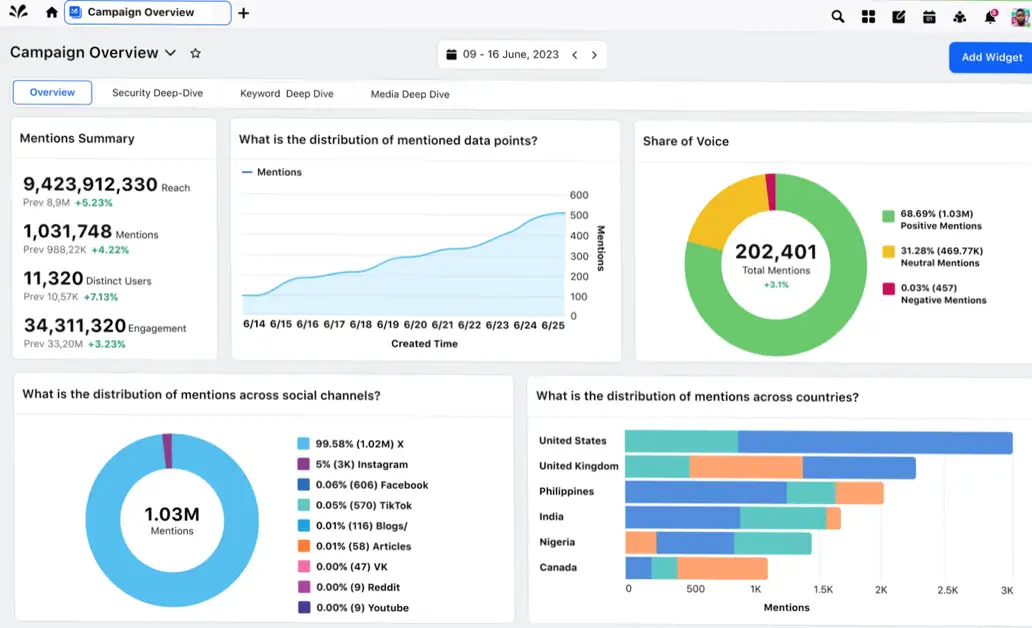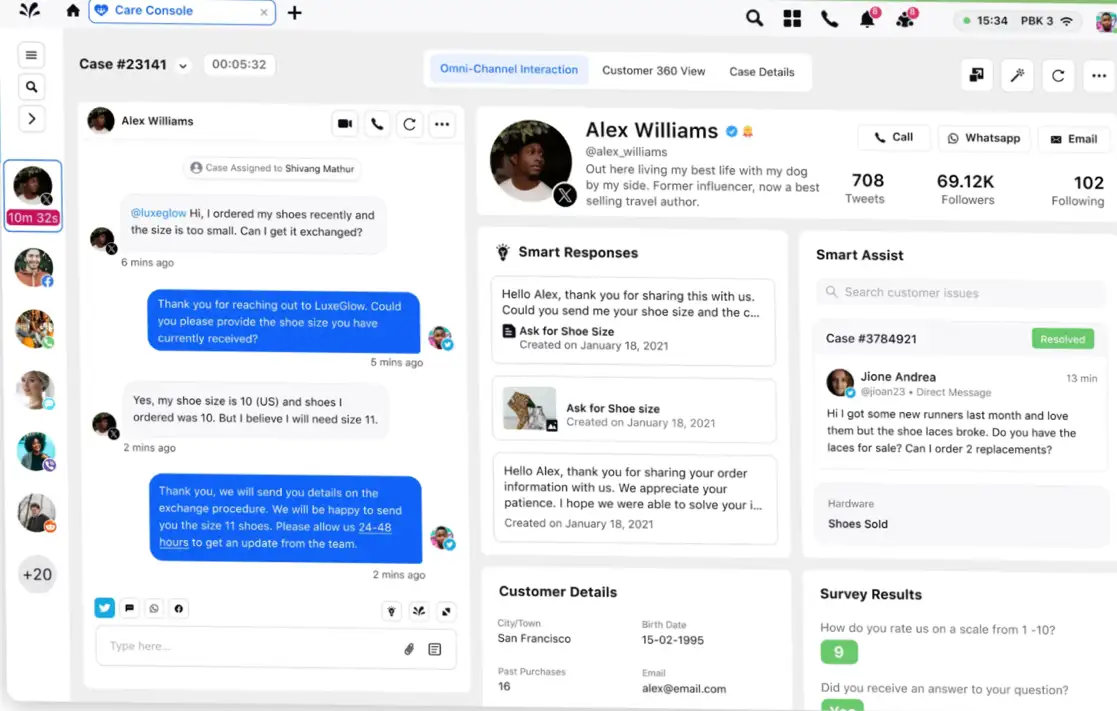The next generation of CCaaS is here
Digital-first customer service, enterprise-scale voice support. Redefine customer service with an AI-powered platform that unifies voice, digital and social channels. Power channel-less interactions and seamless resolution no matter the channel of contact.

Customer Experience (CX) Strategy: The How-To Guide (+Best Practices)
There’s a reason you choose Amazon over eBay or the other way around, even when the price tag is identical. Maybe it’s the frictionless return process on Amazon. Perhaps it’s just muscle memory. But under the surface, it’s the end-to-end customer experience that drives the decision.
This preference doesn’t happen by accident. It’s the result of a carefully crafted customer experience strategy, one that’s embedded into every interaction, across every channel, and aligned with every team.
And the data backs it up: 89% of businesses today compete primarily based on customer experience. That number will only rise as digital channels expand and expectations get more unforgiving.
But let’s be clear: designing a future-ready CX strategy isn’t a checkbox activity. It’s complex. It’s ongoing. And even the most mature enterprises are constantly evolving theirs. There’s no one-size-fits-all blueprint — but there is a way to build a strategy that aligns with your business goals, anticipates customer needs, and scales with confidence.
So, let’s get into it: how do you craft a customer experience strategy in 2025 that gives your brand the edge in a noisy, look-alike market?
What is a customer experience strategy?
A customer experience (CX) strategy is a deliberate, organization-wide blueprint for delivering seamless, valuable, and personalized experiences across every customer touchpoint regardless of the query, channel, or moment in the journey.
At its core, a CX strategy aligns people, processes, data, and technology to ensure that every team across service, sales, support, and product works from a shared vision of the customer, delivering experiences that feel effortless, human, and connected at scale.
A strong customer experience strategy includes:
- A shared CX vision anchored in business outcomes
Think beyond vague aspirations. Your CX vision must translate into measurable impact. For instance, instead of “delight our customers,” aim for outcomes like “reduce onboarding time by X% while increasing product adoption” or “make renewals as easy as sign-ups.” This creates alignment across leadership, operations, and frontline teams. - Customer-centricity is hardwired into every team and function.
Your product, marketing, sales, and support teams need to be tightly aligned on what “great experience” looks like and how their decisions affect it. That means shared metrics, continuous feedback loops, and leadership commitment to a customer-first operating model. Apple Genius Bar is one of the best examples in this regard. - Connected tech and data for a single view of the customer
Siloed systems are the enemy of seamless experiences. An effective CX strategy leverages integrated technology, including CRM, contact center software, VoC tools, AI, and more, to ensure every interaction is context-rich and consistent, regardless of the communication channel — whether it occurs via live chat, phone, email, or social media. Customers should never have to repeat themselves, no matter who they’re speaking to.
Importance of an effective CX strategy for enterprises
For enterprise organizations navigating digital transformation, the stakes for customer experience have never been higher. In 2025, where products and pricing are easily replicated, customer experience is your most durable competitive advantage and your most vulnerable risk area if overlooked.
1. Driving sustainable revenue growth
Customers with positive experiences are more likely to make repeat purchases and recommend your brand to others. Therefore, enterprises with robust customer experience (CX) strategies tend to achieve higher customer lifetime value, improved retention rates, and increased wallet share.
For example, Statista quotes that in the first quarter of 2023, Amazon Prime's 30-day trial resulted in a 72% subscription conversion rate, up from 67% in 2022. Additionally, 97% of members renewed their subscriptions for a second year, highlighting the strong customer loyalty fostered by a positive experience.
2. Reducing operational costs and inefficiencies
A well-defined customer experience (CX) strategy helps streamline operations by reducing repeat contacts, increasing first-contact resolution, and minimizing escalations. When customers can resolve issues quickly — or better yet, prevent them through proactive customer service — you drive down cost-to-serve while improving satisfaction.
3. Breaking down silos across teams and systems
Large enterprises often suffer from fragmented operations, with customer data scattered across CRM systems, contact centers, marketing teams, and product teams. A strategic CX framework forces alignment, ensuring teams collaborate around a unified view of the customer and make decisions based on shared insights.
4. Enabling agility in a rapidly shifting market
Customer expectations evolve faster than most organizations can react — especially in complex, multi-region, multi-product enterprises. An effective CX strategy provides the infrastructure to adapt quickly, including new channels, new journey stages, and new service models. As a result, instead of guessing what customers want, you respond in near real-time.
Now that we’ve understood CX strategy and its importance in today’s enterprise ecosystem let’s learn how to build one for your business.
How to build a customer experience strategy framework in 2025?
In 2025, the smartest CX strategies will be built across three interconnected phases of the customer journey: Pre-purchase, during-purchase, and post-purchase. Each phase requires a distinct approach, yet they must all be integrated with shared data, consistent brand promise, and frictionless handoffs.
Let’s break it down:
Pre-purchase: Creating value before the sale
The pre-purchase phase is your first and often most critical chance to deliver a standout experience. For enterprises, this stage is where fragmented brand messaging, inconsistent digital experiences, or poor lead handling can erode trust before a deal even begins.
Common CX challenges at this stage:
- Fragmented digital presence: With multiple business units or geographies running siloed campaigns, customers often face disjointed journeys and inconsistent messaging.
- Lack of personalization at scale: Modern buyers expect your brand to know their role and pain points before they even fill out a form.
- Slow or generic lead follow-up: Enterprise B2B buyers often make decisions before talking to sales. Poor marketing-to-sales handoffs result in lost opportunities and a broken first impression.
Now, if you are a forward-thinking enterprise, you should not just patch these gaps; you must operationalize around them. Here’s how:
- Build a unified digital front door: Start with a centralized digital experience platform that governs branding, content, and messaging across all markets.
- Leverage AI for real-time personalization: Use AI to tailor website content, chatbot flows, and email sequences based on intent signals.
- Bridge the marketing-to-sales gap with intelligent routing: Integrate your CRM with real-time lead scoring and smart routing. Add contextual automation like chatbot-to-rep handoffs or dynamic nurturing based on interaction history. Think of it like building a warm, data-enriched introduction to sales, not just a lead transfer.
During purchase: Making the decision effortless
At this stage, customers are evaluating you against competitors — and any point of friction can tip the scale. For large enterprises with multiple product teams, pricing tiers, or sales geographies, consistency and clarity are everything.
Key CX challenges and strategic considerations:
- Sales misalignment and complexity: Enterprise buyers frequently navigate complex pricing structures, regional offers, and diverse stakeholder groups. Without unified playbooks and clear approval workflows, the process becomes disjointed and inefficient. Your CX strategy should embed buyer enablement content, streamline internal approvals, and align global teams with a single source of truth.
- Lack of real-time support: Whether it's a pricing clarification, product demo, or contract query, modern buyers expect answers in seconds, not hours. Embedding conversational AI, live chat escalation, and agent-assist software directly into the sales process demonstrates your responsiveness and enterprise readiness.
- Rigid or siloed systems: Legacy CRM, ERP, or CPQ systems often slow momentum. A future-ready customer experience strategy should focus on backend flexibility and frontline agility, equipping teams with adaptive tools that can move at the speed of the buyer rather than relying on internal systems.
🎯 Pro Tip
Prioritize high-impact moments that shape customer perception
Not every interaction holds equal weight. Some moments, like a well-timed chat popup during a plan comparison or a frictionless contract signing, build confidence. Others, like a lag in trial support or an unclear quote, can quietly kill the deal.
The key is to identify the perception-defining moments — the ones where customers hesitate, question, or need reassurance — and design intentional interventions. That might mean faster live chat on pricing pages, automated follow-up when a form is abandoned, or surfacing of the right content during legal review cycles.
You don’t need to contemplate every touchpoint, just the ones that move the needle for confidence, clarity, and conversion. That’s where CX drives outsized ROI.
📚Read More: Customer Experience Mapping
Post-purchase: Creating value beyond the transaction
The moment a customer signs the contract is not the end of the journey — it’s just the beginning. For enterprise brands, this stage is where loyalty is either earned or eroded.
Here are some challenges that frequently occur to customers across various industries after they make a purchase.
- Disconnected onboarding and support: Customers dislike having to repeat information. Yet most enterprises still struggle with poor handoffs from sales to onboarding or from onboarding to support. A strong CX strategy must ensure systemic knowledge transfer and a single source of truth via CRM and CXM integrations.
- Reactive, not proactive, support: In 2025, best-in-class companies don’t wait for issues to arise. They predict and solve them before the customer complains using sentiment analysis, predictive maintenance, and smart alerts. Read: Predictive Analytics - The Next Big Thing in Customer Service.
- Siloed customer service operations: With multiple contact center locations, varied platforms, and inconsistent agent training, post-sale support can feel like a maze. Your customer experience strategy should include a unified CCaaS platform, AI-powered routing, agent assistance, and knowledge management.
📌 Two cents from Sprinklr
The best customer experience doesn’t start at the point of interaction; it begins right at the innovation table. Enterprises that truly lead in CX design their products and services with the customer’s lens from day one.
That means asking: What problem are we solving? How will our customers discover, explore, and adopt this solution? Where are the friction points in time-to-value?
At Sprinklr, we’ve seen that when CX teams partner early with product, engineering, and go-to-market functions, it creates organic experiences—not forced ones. Customers don’t have to “learn” how to navigate your product or service; it just fits. This mindset accelerates customer onboarding, increases adoption, and reduces support costs. It’s a win across the board.
Bottom line: If experience feels like an afterthought, your customers will treat it like one. Build it into the DNA of your offering from the start.
Best practices to implement digital customer experience strategy
Once your CX strategy framework is in place, the real work begins operationalizing it. The difference between a strategy that sounds good on paper and one that delivers real outcomes lies in the rigor of execution.
From years of working with enterprise brands across industries, these six practices consistently separate CX leaders from the rest. Think of them as your non-negotiables — the pillars that will keep your strategy sharp, scalable, and customer-first in 2025 and beyond.
Design a VoC program that drives real action
Customer feedback is more than CSAT surveys or NPS. It’s about context, emotion, and signals that help you see what customers experience before they churn or disengage.
Your VoC program should capture inputs across every channel — calls, chats, social comments, app reviews, and post-purchase surveys — and route them to the teams that can act on them: product, operations, marketing, and even legal.
But here’s the key: Don’t treat VoC as a listening exercise. Treat it like a performance feedback loop for the business. When you see drop-offs in onboarding, use that insight to revisit workflows. When customers complain about wait times on chat, use it to improve routing or deploy AI-powered triage.
The most successful enterprises embed Voice of Customer (VoC) into their product and process roadmaps, not just into quarterly dashboards.
💡Do you know
The most valuable insights into customer experience often come directly from customers and are frequently shared across social media, community forums, review sites, and feedback forms. However, with conversations spread across numerous touchpoints, it's nearly impossible to track everything manually.
That's why customer-centric enterprises turn to Sprinklr Insights. It unifies feedback from over 30 social and digital channels, 400,000+ media sources, and 1 billion+ websites, combining it with your owned data for a complete, 360-degree view.
With real-time firehose access and AI-powered analysis, Sprinklr helps you detect trends, uncover root causes, and get clear, actionable recommendations so feedback becomes a roadmap, not a dead-end.

Ensure your tech stack supports a unified, real-time CX view
Customer perception is shaped in milliseconds, and decisions made without full context can derail that experience just as quickly. That’s why fragmented systems are one of the biggest threats to modern customer experience (CX).
Your CRM, customer service software, feedback engine, digital engagement tools, and social listening software must work together seamlessly. The key is to connect them into a unified customer intelligence layer that delivers real-time, cross-channel visibility.
So, what’s the real objective? It’s one version of truth. One shared customer story. One dashboard that every team, from sales to success, can act on without delay or contradiction.
How Sprinklr helps
Sprinklr’s Unified-CXM platform combines listening, engagement, campaign management, and customer service into a single platform. This convergence enables enterprise teams to collaborate with full context, streamlining operations and delivering seamless customer experiences.
For instance, a global infrastructure and mobility provider utilized Sprinklr to connect insights across airports, highways, and transit systems, enabling faster decision-making, tighter reputation management, and a measurable increase in customer satisfaction.

Build a culture where every team owns a part of CX
Do you view customer experience management as the sole responsibility of your support or marketing team? Well, that’s a recipe for blind spots, duplication, and customer frustration.
Instead, operationalize CX accountability across departments. That means marketing owns the promise, product owns the usability, finance owns billing clarity, HR owns employee CX culture, and they all know how their work connects to customer outcomes.
One Fortune 100 brand we worked with assigns a CX KPI to every functional leader alongside their standard metrics. They gradually unlocked better coordination, faster fixes, and no surprises when escalations arise.
Get stakeholder buy-in to scale CX transformation fast
CX transformations stall when they're seen as a "soft" initiative. To gain traction, you must tie CX outcomes directly to business priorities, such as reducing customer churn, increasing retention, driving revenue growth, and achieving a competitive advantage.
Your C-suite cares about growth. So, demonstrate how an optimized post-purchase journey leads to an X% higher LTV or how proactive support reduces churn by Y% year-over-year. When you connect CX to the numbers that matter, buy-in becomes automatic — not an uphill battle.
Once leadership sees the value, scaling changes across regions, teams, and products becomes significantly easier.
Create a CX governance model for continuous optimization
Here’s a common pitfall: A CX strategy is launched with excitement… and then loses steam. Without clear governance structures, even the best-laid plans drift off course.
Define a CX council or working group with cross-functional representation. Establish regular review cadences — monthly or quarterly — to assess progress, customer feedback, and market trends. Define escalation paths for critical customer issues and align everyone on when and how to pivot.
CX is a moving target. Your governance model ensures that your strategy evolves in line with customer expectations, not after they have changed.
The best-run enterprise CX programs treat governance like product management: agile, responsive, and always accountable.
Think like a customer. Act like a leader.
In today's market, new brands launch daily — loud, fast, and everywhere. But noise isn't the same as clarity. While many focus on internal metrics, workflows, or shiny tools, they forget the one thing that actually drives growth: the customer.
When that disconnect occurs, CX falters, and so do loyalty, revenue, and market relevance.
The best customer experience strategies aren't built on big promises. They're built on listening deeply, fixing what's broken, and acting with precision. It's about identifying signals, both explicit and implicit, and translating them into seamless experiences at scale. That takes more than intention. It takes infrastructure.
Sprinklr's Unified-CXM platform is built for enterprise-scale complexity, unifying customer service, digital engagement, voice of the customer, and real-time analytics into a single, AI-powered system. So you don't just see what's happening; you act on it before it impacts experience.
In the enterprise world, lag is fatal. And the brands that lead are the ones who can see around corners, respond at speed, and scale without compromise.
Are you feeling the pressure to get the customer experience right? Don't guess. Don't wait. Book a free demo and discover how Sprinklr helps global leaders transform customer experience into a competitive advantage.
Frequently Asked Questions
Start by mapping the full customer journey, from offline to online. Identify where customers switch channels, then make the transitions seamless. Unify data across systems, so every team has the full picture. Keep the tone, service quality and brand promise consistent everywhere.
The 7 Es are: expectation, emotion, engagement, ease, effectiveness, execution and empowerment. Together, they guide how customers feel, act and respond at every journey stage. A strong CX strategy covers all seven.
A clear CX vision, mapped customer journeys, unified data, feedback loops, personalization, cross-team ownership and real-time analytics. These elements help deliver consistent, measurable and scalable customer experiences.
It removes friction, personalizes every touchpoint and responds to customer needs quickly. When customers feel understood and supported, they stick around. Loyalty grows from relevance, speed and trust.
Assign shared CX goals. Make performance visible to all teams. Break silos with common data and shared dashboards. Let each function own its part of the journey and hold them accountable to the same outcome.




